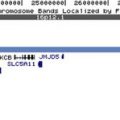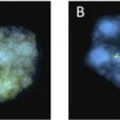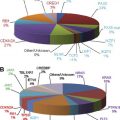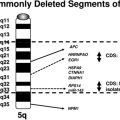Chronic Myeloid Leukemia: Current Perspectives
b Cytogenetics Laboratory, Northwestern Memorial Hospital, Northwestern University, Chicago, IL
Keywords
• CML • Cytogenetics • FISH • t(9;22) • BCR • ABL1
Clinical and Pathologic Features of CML
Chronic myeloid leukemia (CML) is a rare type of leukemia (1–2 per 100,000 people) but is the most common chronic myeloproliferative neoplasm with the proliferation of multiple myeloid lineages. It occurs commonly in older patients with a median age of about 65, although it also affects some pediatric patients.1 Clinically, CML typically has a high white blood count, a massively enlarged spleen (splenomegaly) owing to extramedullary hematopoietic proliferation, and symptoms of chronic fatigue, weight loss, bleeding, and fever.2 Typically, CML consists of 3 clinical phases: chronic, accelerated and blast phases. Before the era of imatinib mesylate (first named as STI571, and then Gleevec) and other tyrosine kinase (TK) inhibitors, the chronic phase usually lasted for 3–5 years, and then eventually evolved to the accelerated and blast phases, when patients presented with a worsening of overall performance status, fever, sweats, weight loss, bone pain, progressive splenomegaly and lymphoadenopathy, and loss of response to therapy.
Leukocytosis, ranging from 20 to 500 × 109/L with a mean of approximately 100 × 109/L, mostly with neutrophilic elements at all stages of maturation and absolute basophilia in the peripheral blood, is one of the striking features of CML in the chronic phase.2 Bone marrow examination shows a typical picture of a granulocytic expansion with increased basophilic and eosinophilic cells, and megakaryocytic proliferation with small hypolobated (dwarf) megakaryocytes in clusters. When CML evolves, peripheral blood and bone marrow analysis shows a further increase in leukocytosis, a high percentage of blasts, and dysplastic features in myeloid lineages and myelofibrosis.
Historical Review of the Philadelphia Chromosome and the t(9;22) in CML and Its Model in Cancer Biology
CML is a hematopoietic stem cell disease always observed with t(9;22) that results in a novel fusion of the BCR (22q11.2) and ABL1 (9q34) genes. The chimeric BCR–ABL1 protein is a constitutively activated TK, and leads to autophosphorylation of the oncoprotein (ABL1) that can activate downstream signaling pathways including RAS, RAF, JNK, MYC, JAK/STAT, and nuclear factor-κB during cell proliferation, differentiation and survival.1
CML serves as the best model for our understanding of the mechanisms of genetic abnormalities in leukemogenesis.3 CML was the first cancer to be associated with a recurring chromosome abnormality. In 1960, Nowell and Hungerford4 identified a consistently small G-group chromosome in leukemia cells in CML, later called the Philadelphia (Ph) chromosome after the place where it was discovered.4 Using novel chromosome banding techniques, Rowley5 demonstrated in 1973 that the Ph chromosome was actually a translocation between chromosomes 9 and 22, i.e., t(9;22), which was the second recurring chromosome translocation identified in cancer shortly after the t(8;21) was discovered in acute myeloid leukemia, also by Rowley in the same year.5 CML was also the first disease in which a molecular rearrangement was recognized as resulting in a novel fusion gene and a chimeric protein that was fundamental to leukemogenesis. In 1982, de Klein6 elucidated that the ABL1 gene at 9q34 was relocated to the Philadelphia chromosome in the t(9;22). In 1984 and 1985, Heisterkamp and associates7 and Groffen and colleagues8 identified the “breakpoint cluster region” (BCR) on the derivative chromosome 22, and later Shtivelman and co-workers9 and Grosveld and colleagues10 revealed that the BCR and ABL1 genes were fused together to give rise to a novel chimeric mRNA and protein in CML with t(9;22). Furthermore, CML serves as the first cancer with a rationally designed drug treatment that directly targets the molecular consequence responsible for the pathogenesis of the disease. By 1996, Druker and colleagues11 were able to identify a TK inhibitor Imatinib that specifically bound to the fusion BCR/ABL1 protein and inhibited the constitutively active ABL1 gene function. Since then, many other novel chromosome abnormalities in leukemia, lymphoma, sarcoma, and recently in epithelial cancer have been discovered, and other genes and protein-specific drugs are used in patient treatment and clinical trials. Therefore, CML is a valid research model in cancer stem cell biology, normal and abnormal hematopoiesis and lineage commitment, disease progression, and in targeted drug development and therapy.3
Cytogenetic Tests in the Diagnosis and Differential Diagnosis of CML
The t(9;22) in CML: Standard and Variants
The standard t(9;22) can be detected by conventional cytogenetic analysis in bone marrow or peripheral blood samples in more than 90% of CML patients. Presumably occurring in a stem cell, the t(9;22) is detectable in all myeloid lineage cells, including granulocytes, monocytes, erythroid precursors, megakaryocytes, and in all B and some T lymphocytes. At the time of diagnosis, the t(9;22) is usually seen in all metaphase cells analyzed from 24- or 48-hour cultures, indicative of a high mitotic index. In the remaining 2% to 10% of patients with CML, a variant of the t(9;22), involving a third (or more) chromosome can be observed. Either the chromosome 9 or 22 may not exhibit the usual abnormal banding pattern; rather, they may show a 3-way inter-chromosome translocation involving 9q34 (ABL1) and 22q11.2 (BCR), and a third chromosome. Certain chromosome bands are commonly involved in variant t(9;22), such as 1p36.1, 3p21, 11q13, 12p13, and 17q25, although all chromosomes have been observed in variant translocations.12 Careful analysis will enable the identification of a 3- or 4-way translocation involving both chromosomes 9 and 22.
In a few cases, the t(9;22) is cryptic such that conventional cytogenetic analysis does not reveal any apparent chromosomal changes at 9q34 or 22q11.2. Instead, insertion of the BCR gene into the ABL1 gene or vice versa has been identified. FISH analysis or polymerase chain reaction (PCR) studies would be needed to detect the BCR/ABL1 fusion. However, in all patients, the BCR-ABL1 fusion, owing to the t(9;22), is the hallmark of CML as recognized by the 2008 World Health Organization classification of hematopoietic and lymphoid neoplasms.2 The t(9;22) is also one of the recurring chromosome abnormalities in acute lymphoblastic leukemia (ALL), in particular in adult patients; the consequence of the t(9;22) is the chimeric mRNA and protein with the fusion between the 3′ end of the first exon of the BCR gene and the 5′ terminus of the second exon of the ABL1 gene on the derivative chromosome 22 (Ph chromosome).13 The breakpoints in ABL1 are always proximal to the second exon in both CML and ALL, whereas the breakpoints in BCR are variably different between CML and ALL. In CML, the breakpoints in BCR are more telomeric in the major breakpoint cluster region (M-bcr, between exons 12 and 15) or micro-bcr region (between exons 19 and 21), giving rise to the P210 and P230 fusions, respectively. In contrast, the breakpoints in the BCR gene in ALL are far more proximal to exon 2 in a minor breakpoint cluster region (m-bcr), producing the P190 fusion. The location of the breakpoints and the amount of the BCR gene that is included in the BCR/ABL1 fusion determines whether the leukemia will be CML or ALL, both showing a similar but not identical BCR/ABL1 fusion protein.13
Secondary Chromosome Aberrations in CML at Diagnosis
The t(9;22) or its variants are detectable as a single cytogenetic abnormality in up to 90% of CML patients in the chronic phase at the time of diagnosis. In some patients, other chromosome aberrations are observed in addition to the t(9;22). The most common ones are loss of the Y chromosome, gain of chromosome 8, and a second Philadelphia chromosome, and isochromosome 17, that is, i(17q). Loss of the Y chromosome is generally related to increasing age (>70 years), and seems to have no effect on the disease course or phenotypic features. Notably, the remaining additional chromosome aberrations, namely, +8, +Ph, and i(17q), are also frequent in CML during the accelerated and blast phases. Thus, it is reasonable that these patients with t(9;22) and additional chromosome aberrations do poorly in comparison with those with t(9;22) as the sole abnormality. In fact, it has been demonstrated that such additional abnormalities indeed are associated with poor survival, and a higher risk of relapse.14 Particularly, the i(17q) is a predictor for poor cytogenetic and clinical response. It remains to be seen if the negative association of additional chromosome aberrations with poor prognosis in CML can be overcome by imatinib treatment.
Cytogenetic Evolution in CML During the Accelerated and Blast Phases
The chronic phase of CML usually lasts about 3 to 5 years, and then evolves to an advanced stage. The disease evolution is accompanied in more than 60% of patients with additional chromosome aberrations, which can be reliably identified by cytogenetic analysis in many cases.12 The most common additions are gain of chromosome 8 (33%), followed by an additional Ph chromosome (30%), i(17q) (20%), and +19 (12%); loss of the Y chromosome (8% in males), trisomy 21 (7%) and loss of chromosome 7 (5%). They may occur individually or in combination. In certain situations, the appearance of additional abnormalities, such as +8 and i(17q), is a strong indicator of an occult disease progression, often several months earlier than morphologic evidence on bone marrow examination or clinical symptoms.
Interpretation of FISH Results in Combination With Cytogenetic Analysis
A combined conventional cytogenetics and FISH analysis is important in CML for diagnosis. Although it is at a low-resolution level, chromosome analysis provides a complete picture of all metaphase chromosome changes. It is particularly helpful to identify a variant of t(9;22) and clonal evolution, which is informative of disease status. FISH not only confirms the t(9;22) but it establishes a reference FISH signal pattern as well for monitoring disease status and treatment response. FISH on metaphase cells helps to identify complex karyotypes and clarify unusual chromosome aberrations, such as 3-way translocations of the t(9;22), a cryptic translocation, or a partial deletion of the genomic fusion on the derivative chromosome 9. In most patients, the percentages of leukemia cells with t(9;22) is comparable in both tests, with a little bit lower percentage seen in the FISH analysis.15,16 Once the FISH pattern has been identified at diagnosis, FISH can be used to monitor treatment response in bone marrow or peripheral blood samples at appropriate intervals, without the need to perform standard cytogenetic analysis. However, before the patient enters hematologic and cytogenetic remission, karyotyping should be done every 3 to 6 months to avoid missing additional chromosome aberrations associated with blast crisis.
Stay updated, free articles. Join our Telegram channel

Full access? Get Clinical Tree








